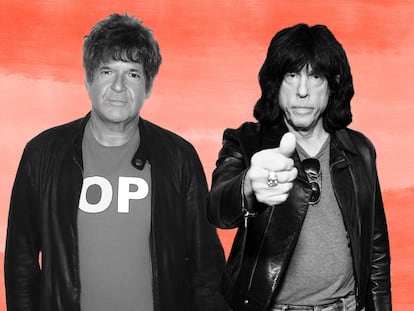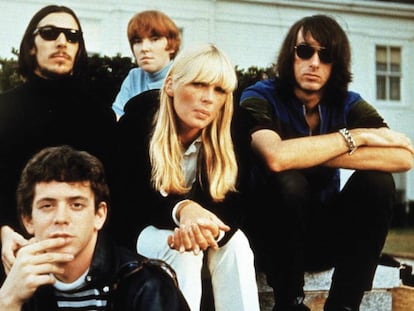Lucy Sante: ‘I tried to be a man, but the truth is that I was never very good at it’
The writer, artist and great chronicler of the New York underground felt from childhood that her gender did not match the one on her birth certificate. Last year, a face modification app brought her a revelation
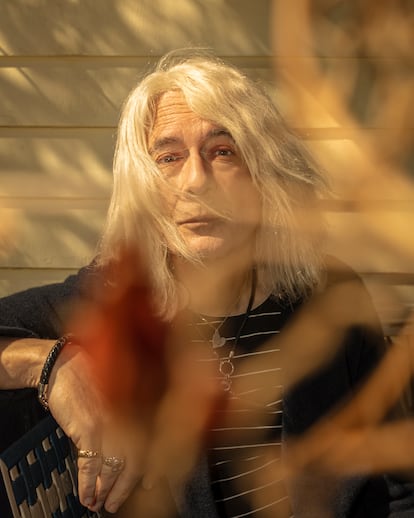
A decade has passed since Lucy Sante last spoke with EL PAÍS. The reason for that occasion was the first Spanish-language translation of her book Kill All Your Darlings, an essay collection about underground American culture. That meeting, as this one, took place at her home in Kingston, the former capital of the State of New York, where Sante had established her permanent residence because she considered that the city where she had spent most of her life, and which she depicted in Low Life (1991), had died. Other essential titles in her bibliography are Evidence (1992), a chilling history of crime in New York between 1914 and 1918, based on photographic evidence taken directly from the city’s police archives, and The Factory of Facts (1998), an autobiographical meditation on the difficulty of setting the limits that define our identity. In 2015, she published The Other Paris, an alternative history of the French capital, which follows the same methodology she used in the book dedicated to New York. Sante taught courses in creative writing and history of photography at the prestigious Bard College for decades. Her chronicles, profiles and essays are on par with Janet Malcolm and Joan Didion.
Maybe the People Would Be the Times, Sante’s most recent title, collects 51 texts on cinema, photography, poetry, music, personal memory and New York, published over the last two decades. Sante profiles characters as diverse as filmmaker Jacques Rivette, Sophie Calle, Patti Smith, Rene Ricard, H. P. Lovecraft, Georges Simenon, David Wojnarowicz and the photojournalist Weegee, chronicler of a little-known New York. In one of its sections, the book relives the era of Manhattan clubs like CBGB, The Mob, Palladium and Fillmore East and the stories of bands like the Ramones and the Beastie Boys, who shaped a city in which, according to the author, “everything interesting is somehow related to music.” The book digs up lives and objects lost in the darkness of the past, including aspects of Sante’s own life, portraits of forgotten experimental artists and the history of the New York tabloid press.
Lucy Sante, who will turn 68 on May 25, was born in the town of Verviers, Belgium. Her father was a metal worker, and her mother, a housewife with strong Catholic convictions, was one of her greatest influences during childhood. At birth she was registered as male and given the name Luc, named after his older sister, Luce Marie, who was stillborn.
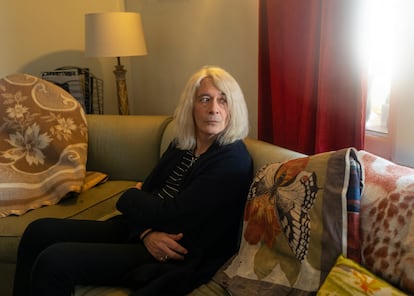
The Santes’ emigration to the United States was somewhat convoluted: Lucy was four years old the first time the family crossed the Atlantic. As the situation changed in Belgium, the family returned to old Europe, but the ostensible recovery was a mirage, and they soon emigrated for the second time. From the industrial belt of New Jersey, Lucy Sante went to New York to study at a prestigious high school, and from there went to Columbia University, where she enjoyed the friendship of Jim Jarmusch, who remains a friend, and rubbed shoulders with figures including Allen Ginsberg and Kenneth Koch.
This interview takes place in the kitchen of her house. On the table there is an English copy of her latest book, on whose cover, unlike the later Spanish version, Sante still appears as Luc. A few weeks ago, Sante published a long essay in Vanity Fair explaining why, at almost 70 years of age, she decided to transition. I ask her about it.
“In the middle of February of last year, I bought a new phone and I decided to try an application called FaceApp that allows you to make changes to your image, such as looking younger or older or changing gender. It wasn’t the first time I had done something like that. I had done it with less sophisticated phones and always destroyed or hid the images, but this time it was different. The images were very high-quality, and I had a real shock. I immediately went through the app with all the pictures of myself I could find, starting when I was 12 years old or even younger, and suddenly I saw in front of me an alternative version of my life, my life as a woman. I understood that I could not deny or ignore such a thing. It opened a door in the depths of my being and everything overflowed. It was very quick, like an earthquake that started a transformation process that lasted about six months, maybe more, from the revelation I had in February. I shared it little by little, first with the people closest to me, such as my partner, my son, my therapist and my closest friends. Then I told more and more people, my university colleagues and other friends, until finally, in September, I made it public on Instagram. During all that time, I was in a continuous state of exultation. Everything fell into place. I didn’t have a single moment of doubt, not one, because what suddenly surfaced was something that had been on my mind since childhood. I had always refused to see it, but once I started I had no choice but to follow through to the end.”
Sante pauses and pats the cover of the book. She picks up a pen, opens the volume, and delicately crosses out Luc’s name with a single stroke. The essays that make up Maybe the People Would Be the Times cover the interests she has had throughout her life. They also contain the most intimate keys to her writing. “I am interested in what is little known,” she says, turning the volume upside down to hide its cover, “what has been forgotten, what, when rescued, reveals itself as entirely new, what is free of clichés and stereotypes. Real art doesn’t get old. It doesn’t matter what time it’s from. Any artist or writer I admire is my contemporary, someone I can learn from, and if critics and academics haven’t touched them, they are even more alive to me.”
These words apply equally to musicians, visual artists and writers, whose profiles she traces in her writings. They are most true, though, of photographers erased by the passage of time. “For almost 25 years, I taught the history of photography at Bard College. In addition to the essential figures of Walker Evans and Robert Frank, I am interested in the work of Eugène Atget, Berenice Abbott, Brassaï, Saul Leiter, but above all I am attracted to little-known or unknown photographers, even anonymous ones, from the end of the 19th century and early 20th century, whose work is both very clear and very mysterious,” he says.
Clear and mysterious at the same time: the formula sums up Sante’s style. Her methodology involves a sort of archeology of the invisible, which consists of discovering unusual connections that sometimes occur over time and space. That’s how she wrote her books on Paris and New York. “I am passionate about certain types of space-time conjunctions,” she says, reciting, “Valparaíso, 1952; Dar es Salaam, 1966; Brooklyn, 1933; Tokyo, 1905. If I have the right research tools, and I can incorporate randomly found references, such as photographs, newspapers, theater programs, train schedules, telephone directories, then I can insert myself into that world and write about it.”
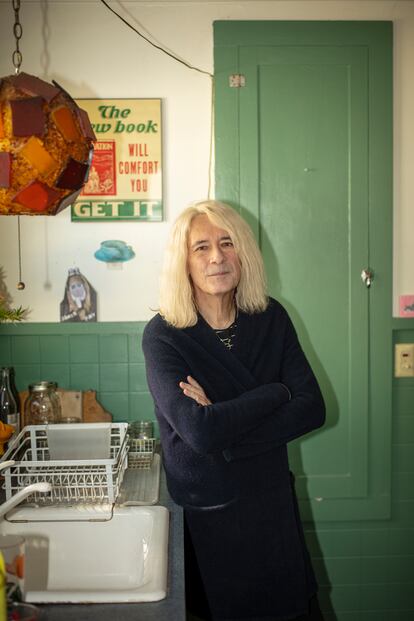
Lucy Sante’s most moving essay is, by far, her self-portrait in Vanity Fair. The story is written with the same cleanliness and clarity as her other work. Will this radical change have intellectual repercussions?
“The change that I’ve experienced is so deep that I am still processing it, and I’m not yet in a position to analyze it. My way of relating to people has completely changed. I have become a much more sociable person. I no longer have anything to hide, and that’s a huge relief. I was living with a secret that drowned me without my realizing it. When I see photos of myself from before, I realize that I was not happy. That has disappeared. I haven’t seen any change in my intellectual process, but emotionally I have changed, and that will inevitably be seen. It will probably be more difficult for me to notice than for other people, but it is interesting. Will it change my way of writing? I’m very curious to know what could happen. When I told my partner of 15 years about my decision, one of the first things she asked me was, ‘Are you finally going to write a novel?’”
At no point in the conversation does Sante refer to anyone by name, although she speaks with particular emphasis about how those closest to her, particularly her partner and her son, reacted when she told them of the decision she had made.
“I was mentally prepared to deal with people stopping talking to me, but none of that has happened. I expected to receive hostile mail. I haven’t. Everyone has been extraordinarily kind and positive. When I shared the news at the university, I received expressions of affection and support from both my colleagues and my students. The hardest part was telling my partner. She was the first to know. I shared this house with her, and we went through the pandemic together. We are still very good friends, but the romance, which had lasted 15 years, could not survive. I was devastated, but I had to listen to the truth. My son took it naturally. At first he was surprised, of course, but he belongs to a generation that has been in contact with young trans people since the age of 12. It is part of his world, his games, his life. What interested him most was knowing what to call me. I told him I was still his father. At first it seemed strange to him, but now he feels comfortable with the idea.”
As far as her daily life is concerned, nothing has changed. Her daily routine remains the same. She takes long walks near the Hudson River, reads and writes. She is preparing a trip to Europe. The biggest change is the intense friendship she has forged with a transgender woman 47 years her junior who studied photography at Bard. Lucy speaks of her new friend with immense affection, although she carefully avoids naming her. What she has been experiencing for a year, she explains, reminds her of what happened when she left Belgium and had to immerse herself in a new culture and learn a new language. She now finds herself, once again, in uncharted territory.
“No one knows much about gender dysphoria,” she points out. “It’s all speculation. Part of the process is taking a look back at your life through a new lens that allows you to review everything from a perspective that didn’t exist before, and looking back I realize that I have never been a man. I tried, yes, but the truth is that I was not very good at it. For me, being a man meant having to draw an invisible circle around myself, a circle that no one could enter. I sought to be unknowable. I didn’t want to be harsh or cold or distant, but I also didn’t want anyone to get too close or get too deep into me, until I had this revelation. Then everything changed. Over the years, trying to understand what was wrong with me, there were times when I thought it was all a matter of fetishism. Sometimes I thought I was a transvestite, which didn’t seem healthy to me. On the other hand, I am attracted to women. I have never been attracted to men. That was another reason why I thought I couldn’t be trans, because I’m not attracted to men. But all these mysteries around who I was and how I behaved were suddenly explained by the revelation I had when I found out that I am a woman.”
When asked to talk about her current projects, her eyes light up: “I have many. One of them, inevitably, is that I am going to write my memoirs as a transsexual. I started to write a book about Lou Reed, but I decided to expand it and tell the story of The Velvet Underground, with the New York of the 1960s as a background. It’s one of the most fascinating periods in the history of the city, and there’s hardly anything written about it. I am also writing the script for a television series, a documentary about the clubs of my youth. I am writing the script and I also have to narrate it. It is very interesting. I’ve started hormone treatment. That’s all for now. I’m not considering surgery, but my voice hasn’t changed. My voice has to tell a different story from the one told by the images or the interviewees. It’s like writing a poem for television and reciting it myself. It is perfect.”
Tu suscripción se está usando en otro dispositivo
¿Quieres añadir otro usuario a tu suscripción?
Si continúas leyendo en este dispositivo, no se podrá leer en el otro.
FlechaTu suscripción se está usando en otro dispositivo y solo puedes acceder a EL PAÍS desde un dispositivo a la vez.
Si quieres compartir tu cuenta, cambia tu suscripción a la modalidad Premium, así podrás añadir otro usuario. Cada uno accederá con su propia cuenta de email, lo que os permitirá personalizar vuestra experiencia en EL PAÍS.
¿Tienes una suscripción de empresa? Accede aquí para contratar más cuentas.
En el caso de no saber quién está usando tu cuenta, te recomendamos cambiar tu contraseña aquí.
Si decides continuar compartiendo tu cuenta, este mensaje se mostrará en tu dispositivo y en el de la otra persona que está usando tu cuenta de forma indefinida, afectando a tu experiencia de lectura. Puedes consultar aquí los términos y condiciones de la suscripción digital.
More information
Últimas noticias
ICE raids trigger school absenteeism and traumatize children: ‘They have been forced to leave their childhood behind’
The guardians of the meteorites of the Argentine Chaco
Helen Levitt, the photographer who captured the theater of the everyday
The life of a delivery driver in China: ‘Many people don’t know how an order can arrive at their home in just one day’
Most viewed
- Christian Louboutin: ‘Young people don’t want to be like their parents. And if their parents wear sneakers, they’re going to look for something else’
- US sanctions against jailed cartel leader ‘El Marro’ highlight Mexico’s lack of control over its prisons
- The low-cost creative revolution: How technology is making art accessible to everyone
- Liset Menéndez de la Prida, neuroscientist: ‘It’s not normal to constantly seek pleasure; it’s important to be bored, to be calm’
- Cartels in Mexico take a leap forward with narco-drones: ‘It is criminal groups that are leading the innovation race’
